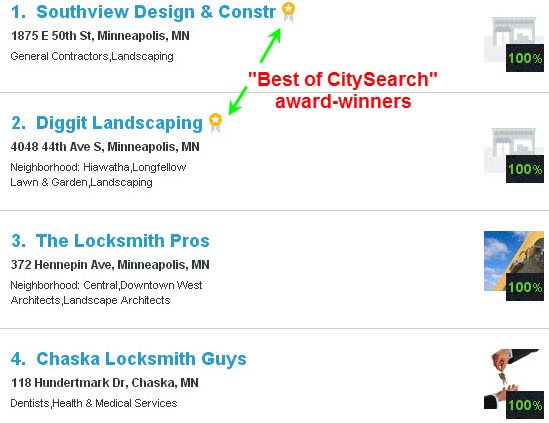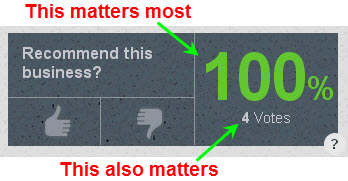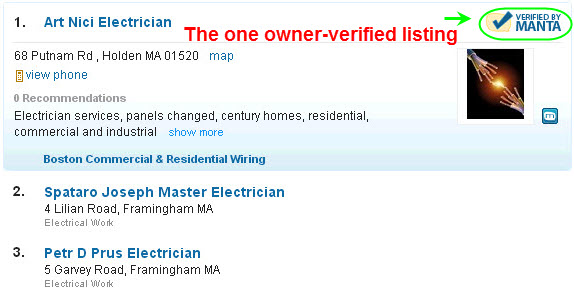Though the first page of Google’s local results usually consists of 3 “local map” results plus 10 organic results, that doesn’t mean your business has 13 chances to rank somewhere on page one. Nor do all pages on your site have an equal chance at ranking. Nor does having the most-dominant site necessarily mean you’ll get the most or best visibility in the local results.
How well your business ranks in the local “3-pack” depends on many factors, including where your business is, where the searcher is, who clicks on you and other behavior, the name of your business, and – above all – on how well you rank in the local organic results (the “10 blue links,” usually right below the local map).
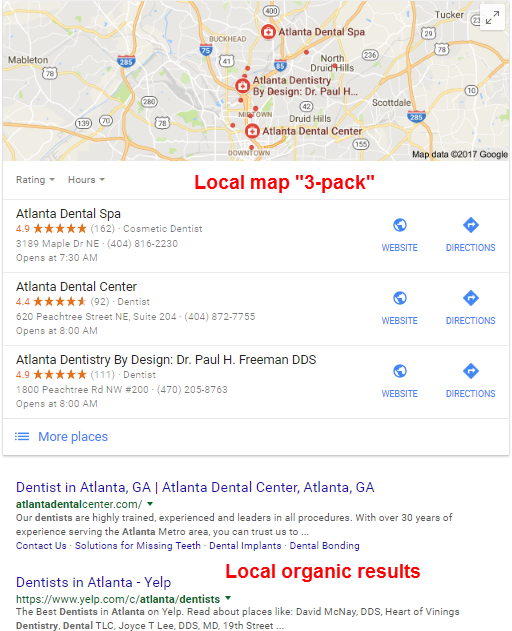
Your organic rankings, in turn, depend mainly on how relevant your site is to what the customer searched for and (even more so) on how good your links are.
So what are your chances of getting your business’s site to rank somewhere on page 1 of the local organic results?
One way to answer that is to know how Google usually fills up the first page of local organic results – Google’s tendencies and quotas, you might say.
Google has a very specific way of carving up the local search results. It’s not all local businesses, nor is it a grab-bag of “something for everyone” search results.
I’ve just done a study of 500 local markets – 500 first-pages of local search results – and have some numbers on which sites and pages typically rank on page one.
Here’s the pie-chart, which sums up my findings and the dozens of hours of research that went into it.
(click to enlarge)
You may not need to know any more. Or you may want more detail on the pie, on my methodology, and on what it all means for your local SEO strategy. In the latter case, just read on.
What does each slice of the pie represent, exactly?
“Business: homepages”
I’m referring to the homepage of a site that belongs to a specific business.
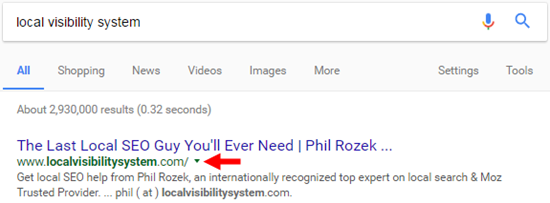
Homepages are the biggest slice of the pie, averaging 37.62% of Google’s local organic search results. On average, 3-4 out of 10 of the organic results consist of one homepage or another. The homepage typically has the most link-juice (which is one reason I usually suggest using it as your Google My Business landing page). It’s no surprise to me so much of page one goes to various homepages.
“Business: subpages:
If homepages constitute more than 3 out of 10 spots on a typical first page of results, that must mean other pages usually grab the other 7 spots – right?
Wrong. Subpages (like yourbusiness.com/city) and subdomains (like city.yourbusiness.com) only account for 12.68% of the 5000 individual search results I studied. In a typical first page of results, only 1-2 results are for pages on a business’s website other than the homepage.

So 37.62% of the results are for businesses’ homepages, plus 12.68% are for other pages on businesses’ sites. That’s about half of the pie.
Who gets the other half of Google’s local organic search results?
“Directories: category search”
It probably doesn’t surprise you that local-business directories take up a lot of real estate on page one. I’m talking about Yelp, BBB, YellowPages, and so on, and industry-specific sites like Zillow, HealthGrades, TripAdvisor, etc.
Those directories’ internal search results show up more often than do other pages on their sites. “Search results within search results” take up a whopping 36.62% of Google’s local organic results.
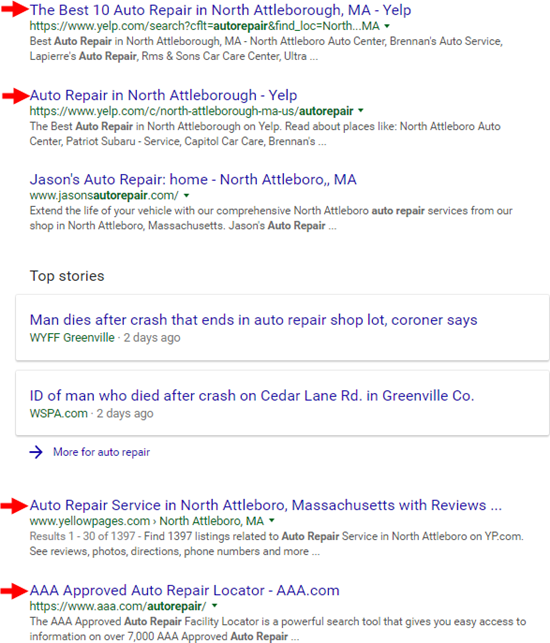
“Directories: business pages”
Sometimes a business’s Facebook or Yelp or BBB or YellowPages page will rank on page one for a popular search term.
Known as barnacle local SEO, it’s great if you can get an online property other than your site to rank for a main keyword. But it’s tough to do. Only 7.58% of Google’s search results go to directory results for specific businesses.
“News”
Local-news sites and other sources of news take up a small piece of the search results (not as much as I thought they would). News results made up 0.64% of the results I studied.

Good coverage can drive business. A unfavorable piece can dog you. News stories tend to have many backlinks, usually are on authoritative sites, and tend to get clicked on often. Because of those things, news pieces can stick around for a while. The news isn’t always “new.”
“Other”
Google throws other results onto page one, too. The most-common “other” sites I ran across were Craigslist listings, Indeed.com (for jobs), weird directory results (e.g. Yelp forum threads), and government sites – usually local government.
Methodology & notes
When Sydney Marchuk (of Whitespark) and I did this research, we tried to be as methodical and scientific as possible. As with most studies, there are limitations to this one, and I’m sure there are some holes.
You can look at our raw data here, but here are some lab notes:
- We Googled 500 different search terms – 500 different combinations of cities and keywords
- We searched for explicitly local search terms: “city + keyword.” As opposed to typing in “keyword” and seeing what local search results Google shows you. (Yes, Google is watching you.) In my experience, the results differ a little between when you type in the city and when you don’t. To do a study on that would be more technically complicated and even more of a slog, but I’d love to do one or see one some time.
- As I said at the start, we didn’t include the Google Maps “3-pack” rankings in this analysis. Again, we just looked at the localized organic results – which usually contain all the business that rank in the 3-pack.
- Sydney lives in Canada, but searched at Google.com (not .ca), was signed out of Google, and used an incognito browser tab. The results weren’t biased by search history or anything like that. In any case, I live in Massachusetts, and the searches I did matched up with what Sydney found.
- We did the research in mid-December – about a month ago. Some of the SERPs surely have changed since then, but I doubt they’ve changed significantly. To the extent I’ve had to spot-check some of the results in the past few days, I’ve found that they’ve changed very little.
- Of course, the breakdown will change over time. It’s Google. They like to twist the dials.
Conclusions (very general)
What does the breakdown of a typical page one mean – especially for your business? Some things I’ve gleaned from looking at the data (and from doing local SEO for 8+ years):
- On average, only about 5 of the results are for specific businesses. Your other competitors are directories. Wherever you can’t beat ‘em, join ‘em. You’ll get some visibility either when people click on the directories’ “search results within search results,” or if you get your listing or page itself on the site to rank on page one of Google’s local results. That’s often just a matter of piling on the reviews.
- Homepages dominate, especially in markets where smaller, locally-based businesses duke it out mostly with each other, and not as much with Big Ugly Corporations that happen to have a nearby branch. Again, homepages tend to have most or all of the link juice. Assuming you’ve got at leasta few decent links, if you have some good local content on your homepage it should have a good chance of ranking well.
- Subpages (example.com/city) tend to be more dominant in markets where big businesses tend to congregate (e.g. car rentals). I have my theories as to why that is, but that’s for another day.
- Your crappy keyword-stuffed blog post from 2 years ago probably won’t rank on page one for any semi-competitive term. (Maybe if it attracted some good links.)
- Given how Google splits up the real estate between directories and businesses’ sites, dominance isn’t a matter of just getting your site to rank. As I’ve said, it’s not about site vs. site; it’s reputation vs. reputation.
Here’s the pie, once again:
—
Any questions on my findings?
Any conclusions you’ve drawn (that I didn’t mention)?
Leave a comment!
P.S. If for some crazy reason you want to do an (unrelated) study of your own, consider hiring Sydney to help (schedule permitting). You can email me, or connect with her on LinkedIn.



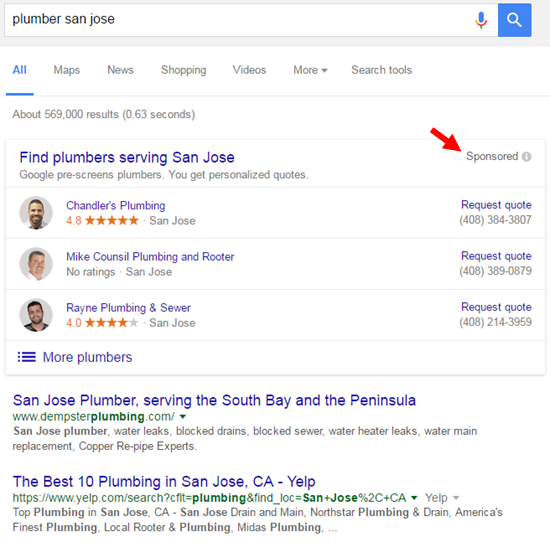
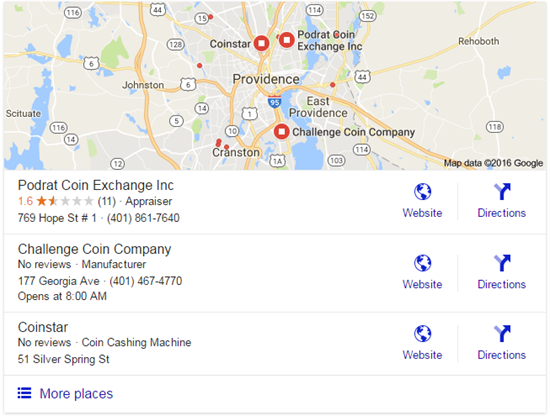
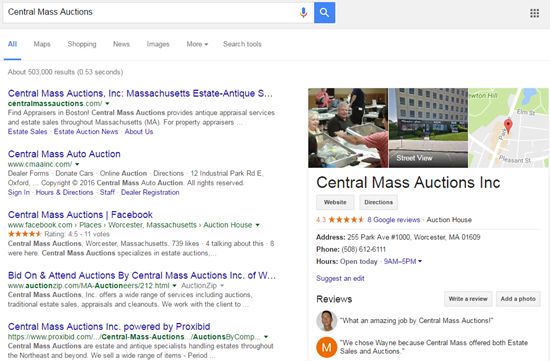
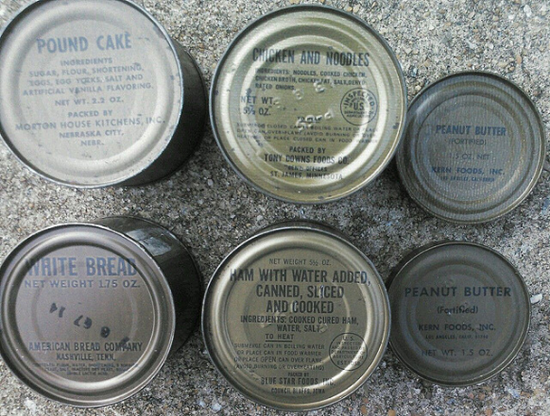
 You might be thinking that this sounds a lot like my post titled “
You might be thinking that this sounds a lot like my post titled “
